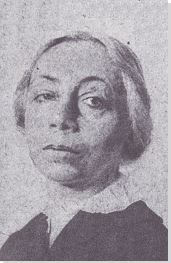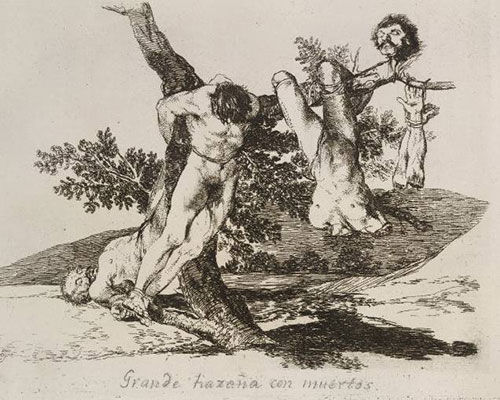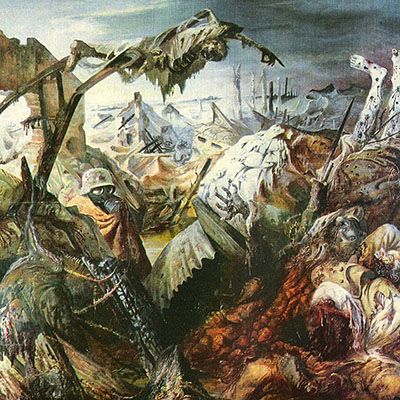Summary of Käthe Kollwitz
Fiercely committed to portraying the plights of workers and peasants, Käthe Kollwitz rendered the grief and harrowing experiences of both historical and contemporary wars in the first decades of the 20th century. Bucking usual artistic trends, Kollwitz adopted printmaking as her primary medium, and drawing from her own socialist and anti-war sentiments, she harnessed the graphic and expressive powers of the medium to present to the public an unvarnished look at the root causes and long-lasting effects of war. While her interest in printmaking and sometimes her subject matter coincided with the Expressionist painters in Germany, she remained independent from them, charting her own path in the burgeoning world of modern art.
In following the example of Goya's print series, The Disasters of War, Kollwitz's depictions of rebellion, poverty, and loss refuse the melodrama of war and sacrifice and instead concentrate on specific personal experiences that can be understood by many. In addition to her powerful visual legacy that still reverberates among graphic protest artists, her role as a recognized, leading female artist of the time ensures her place in the annals of 20th-century modern art.
Accomplishments
- While Kollwitz initially began her artistic training as a painter, she quickly found her voice in printmaking. Over the years, as she mastered several different printmaking techniques and experimented with combining them, she was able to simplify her graphic compositions, removing extraneous details and imbuing them with even greater emotional effect that had a more universal impact.
- While many modern artists explored the realms of abstraction to convey the ramifications of modernity and war, Kollwitz committed herself to an expressive naturalism in order to convey more deeply the range of emotions and experiences unleashed by these difficult times.
- As an artist and a mother, Kollwitz was instrumental in establishing new ways in which modern women could portray themselves in art outside of traditional guises. Kollwitz created several self-portraits and portrayed women working, mourning, and leading revolutions. In particular, Kollwitz explored the subject of motherhood in all of its complexity throughout her long career.
- While noted as a highly skilled printmaker, Kollwitz also turned her attention to sculpture, creating several memorials that explored her abiding anti-war themes of mourning and grief in three dimensions. Sometimes drawing on religious themes, such as the pietà, Kollwitz's sculpture embody a deep empathy with human suffering.
Important Art by Käthe Kollwitz
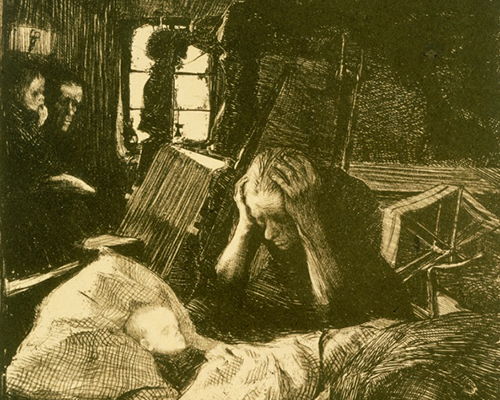
Misery (Not)
Kollwitz's aesthetic response to Gerhart Hauptmann's play about the 1844 German weavers' rebellion resulted in the series The Weavers' Rebellion, an intimate reflection of the artist's valuation of and affection for the working classes. Biographer Martha Kearns notes that the series is unique for its depiction of working class people "initiat[ing], execut[ing], and suffer[ing] the fate of their own uprising" and for its presentation of women as active participants in a violent confrontation. Critically, departing from Hauptmann's play, Kollwitz began her series with Misery, a scene showing the death of a child from the deprivations of poverty, which situated her illustration of the weavers' rebellion as a direct reaction to a life cut short by low wages and inhumane living conditions.
Hopelessness and grief drive Misery's narrative. The print's focal point is the deceased child's bedside, with his mother, beset with sorrow, kneeling beside him, her head in her hands with despair. The child is small, almost skeletal, and bathed in an angelic, bright white light which lightens the dark, wretched room and illuminates the mother's arms. With this choice, Kollwitz illustrates the child's status as an innocent victim, a casualty in the oppressive workers' conditions which prevented survival. The unnaturally grim darkness of the interior, where the bright sunlight stops at the window and only the glow from the child creates any brightness, reveals a large loom and the child's father holding a sibling. The father's eyes are downcast, but the sibling looks directly at the loom, signifying the cause of the family's misery.
Upon starting the series, Kollwitz realized her lack of extensive etching training, and she noted that she "had so little technique that my first attempts [at the series] were failures." She then reverted to lithographic technique to make the first three prints and finished the remainder as etchings, which she perfected with a combination of drypoint, acquatint, tusche wash, and soft ground processes. This series represented a melding of mediums unconventional for a print series at the time. When it was first shown at the Great Berlin Art Exhibition in 1898, it would have earned the gold medal prize, had it not been for Emperor Wilhelm II's declaration of the series as "gutter art." She would, however, win the gold medal for this series the following year.
Lithograph on yellow-brown chine collé mounted on thick white wove paper - Smith College Museum of Art
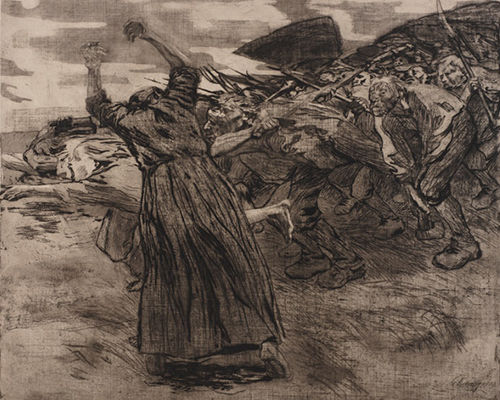
Outbreak (Losbruch)
Kollwitz was taken with the notion of female revolutionaries and was fascinated with the story of "Black Anna," the instigator of a 16th-century, widespread peasant rebellion. In preparatory drawings for The Peasants' War (Bauernkrieg) series, which illustrated the historic revolt, the artist even used her own likeness as a model for Anna. Outbreak, one of the original prints Kollwitz and the 5th plate conceived for the series, depicts Black Anna as a lone woman, inciting the peasants to defend themselves and their families.
It is, in many ways, a progressive reimagining of female agency in revolutionary times. Viewers are reminded of Eugène Delacroix's 1830 Liberty Leading the People in which the personification of liberty is a woman who leads men and boys of various social classes onwards towards freedom, stepping over the bodies of those who sacrificed themselves to the cause. Yet, Delacroix's woman is an idealized type who leads with her sexuality and maternity; her breasts are inexplicably bared and centralized in the composition, and her profile is of a classicized prettiness. In Outbreak, Kollwitz, in contrast, maintains the female peasant's agency. Black Anna's back is to the viewer, as the woman's focus is on the peasants making the charge, rather than on the need to display herself. She is dressed identifiably as a peasant, and she projects strength, solidity, and righteous anger through her frame and her raised, bent arms and clenched fists. Her body tilts, guiding the rebels onwards. Naturalism here is subverted to the emotional cadence of print, with frenetic lines and low, elongated, diagonally oriented bodies underscoring the rush, energy, and collective drive of the peasants in their uprising.
This work, upon submission to the Association for Historical Art, led to the Association commissioning Kollwitz to create an extended print series based on the Peasant War, and she subsequently added six additional etchings to create a total of seven prints on the subject.
Line etching, drypoint, aquatint, reservage, soft-ground etching with impressions from two types of fabric and Ziegler transfer paper - Smith College Museum of Art
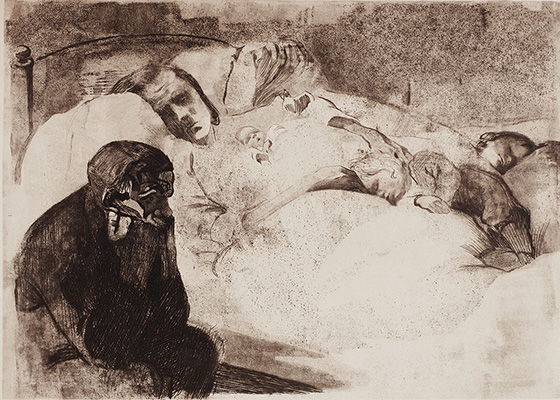
Unemployment (Arbeitslosigkeit)
Kollwitz dedicated herself to documenting and therefore bringing awareness to all manner of social ills and particularly to their consequences within the domestic sphere. In Unemployment, the artist depicts a distraught man in the lower left foreground, his body shadowed and his features sharply delineated with close, black lines and cross-hatching. We see his eyes widened and his brow furrowed in worry as he sits by the bedside of his wife and three sleeping children, contemplating his inability to provide for them. For this family, the distance between sleep and death in impoverishment is visibly slight. Kollwitz rendered the woman and her children bathed in an angelic light, their forms ill-defined but seemingly physically interconnected. The mother, between sleep and wakefulness, indicates her knowledge of their dire situation, as her face, in contrast to her body and those of her children, is darkly shadowed and her eyes hooded.
The artist also calls attention to the mother's hands cradling her child's head to illustrate the promise of eternal maternal protection that circumstances may not allow her to give. In here and in other images, Kollwitz's emphasis on the beauty of her subjects' hands can be traced to fond memories of her beloved maternal grandfather, the radical preacher Julius Rupp, who the artist recalled had "very beautiful" hands, and her own mother's similarly beautiful hands.
Etching and aquatint on paper - Smith College Museum of Art
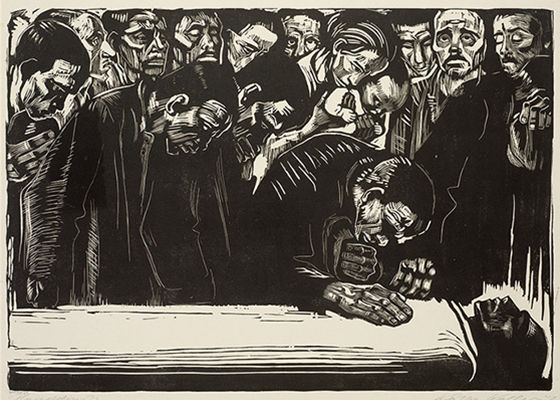
Memorial for Karl Liebknecht
In 1919, Rosa Luxembourg and Karl Liebknecht, co-founders of the Marxist anti-war Spartacus League, were summarily executed for their connection to the January 1919 Spartacist uprising. Kollwitz, who was aligned with the politics of Marxist circles, visited the Liebknecht home on the morning of the funeral; she offered her personal condolences and, at the request of the family, made drawings of the slain leader. She initially began her image of Liebknecht as a lithograph but later completed it as her first woodcut print.
Kollwitz's homage to Liebknecht is as much a tribute to the man as it is a statement about the immortality of his ideas and actions. The subject of the woodcut is Liebknecht's memorial, where the artist depicts him lying in state with mourners coming to pay their respects. The composition is arranged as an interplay between rigid horizontality and tilting arcs. At the bottom center of the woodcut, Liebnecht's body is rendered as a stiff, stone horizontal slab, which parallels the horizontal edge of the paper.
Though he is nominally the subject of the print, Liebknecht's body occupies merely the lowest fifth of the image; the woodcut's energy and primary subject are, in actuality, the mourning group, which occupies most of the composition. The mourners are male workers of varying ages, with a woman and child prominently in the foreground. Kollwitz organized the crowd along an arc, each figure's head and torso slightly bowed towards Liebknecht in respect. Liebknecht's horizontal form is eternally inert. In contrast, Liebknecht's mourning followers are dynamically rendered, both through the curved orientation of their bodies and through the faces' individuality, each person differently reacting to their leader's death. The woman and child literalize the future generations who benefit from Liebknecht's ideology, and the man in the foreground, his head bowed and his overemphasized hand prominently resting on Liebknecht's chest, illustrate the work and the physicality of engagement necessary to continue Liebknecht's ideological fight.
Some members of the German Communist Party objected to Kollwitz's woodcut, however, on the grounds that Kollwitz herself, though a committed radical in her political leanings, was not an official member of the party.
Woodcut on paper - Rhode Island School of Design (RISD) Museum
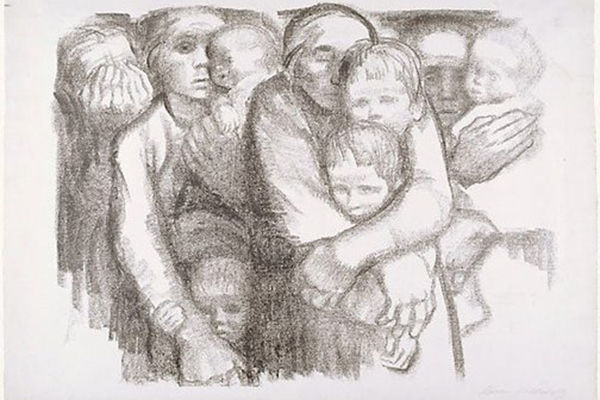
The Mothers (Mütter)
While not included in the final series War, Kollwitz created The Mothers as she attempted to shift from woodcuts to lithographs for the series. She completed this lithograph on her deceased son Peter's birthday, and a self-portrait of Kollwitz as a mother, embracing her sons Hans and Peter as small children, dominates the foreground.
The theme of mothers occupied the artist's work, from her early social justice imagery to her explorations of war, grief, and the less visible consequences of conflict. Here, Kollwitz illustrated the predicament and psychological toll of sons enlisting or being drafted into war on the mothers they left behind. The woman on the print's left covers her face with her hands, bereft and in emotional agony at the loss of her son. The two women on either side of Kollwitz's self-portrait clutch their children in fear and enfold them in their arms; with their prominent, strong hands, these mothers shield their babies and young children from their uncertain future and the awaiting threat of eternal separation. Kollwitz and her sons in the foreground represent the limits of a mother's protection. By 1919, her older son Hans was an adult, and Peter had perished in the First World War in 1914. The children she embraces are therefore the memories of her sons as youths. This interpretation suggests that while the strength of the artist's arms around her offspring illustrate the intensity of a mother's desire to protect her children, in the face of war's unpredictability along with adolescent and adult independence, all a mother can ultimately protect, and all she may be left with, is her memories of them.
Lithograph - Art Gallery of New South Wales, Australia
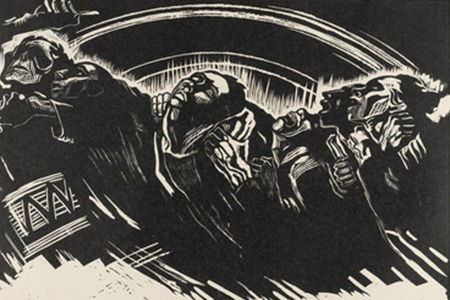
The Volunteers (Die Freiwilligen)
In this second plate from her War (Krieg) series, Kollwitz captures at once the energetic spirit of youth - with young boys, consumed with patriotism and a sense of a higher purpose, volunteering for battle - and the future consequences of those decisions. With the woodcut's thick, graphic style, Kollwitz shies away from detail and instead creates a pared-down composition that emphasizes figural movement. The volunteering soldiers are aligned in a curve, buoyed upwards from the bottom right to the top left of the image as if propelled by the powerful force of their convictions. With the exception of the central figure, the boys look up toward the light, their mouths open in song, their hands and arms clasped around each other in collective solidarity. The boy in the top left beats a drum to lead his fellow soldiers onward and into the conflict with soaring spirits.
Yet, Kollwitz foreshadows the horrors which await these innocent young men. The thick, graphic strokes of the woodcut hollow out the boys' faces, presciently evoking the skeletons they will become, while the drummer, whose call to join the war beats louder than all, has already transformed into the specter of death, his pointed finger indicating the future of the wide-eyed comrade encircled in his arm. On the image's right, the open mouths of two boys in song become the mouth agape in a scream of terror in a third. The central figure, his face aglow with the light of optimism, volunteers for war with his eyes shut; he refuses to see, or cannot see, the danger into which he marches. In choosing to place this boy at the print's center, the artist indicates that part of war's tragedy is the innocence of the idealistic young men who voluntarily gave up their lives for what they believed to be a greater cause, without seeing or being able to see the senselessness of their sacrifice.
In the second state of this print, Kollwitz identified each of the soldiers by name as her son Peter's friends, who were also killed during the First World War. In curator Henriëtte Kets de Vries' words, Kollwitz wanted to ascribe "universal importance" to Peter's death, and, from then on, her own "personal loss...came to be intimately intertwined with...public causes" that she promoted. Like her contemporary Otto Dix, who explored his experience as a soldier with his 1924 print series Der Krieg, and her inspiration, Francisco Goya, with his 1810-20 The Disasters of War print series, Kollwitz critiqued war from the vantage point of her own experience. In War, she chose to emphasize the emotional, psychological, and personal consequences of conflict on those who participated and on those left behind, rather than the horrors of battle itself.
Woodcut on paper - The Museum of Modern Art, New York
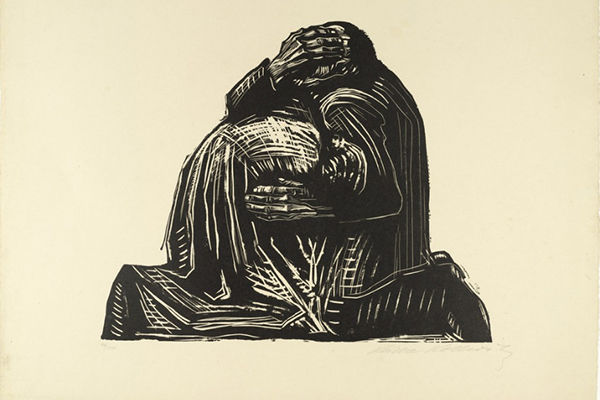
The Parents (Die Eltern)
Unlike her previous two series, the Weavers and The Peasant War, Kollwitz's War cycle was, in biographer Martha Kearns' words, "wrested from Kollwitz' own life." The series of seven prints thus represented an "impassioned protest against the gross senselessness of war" and "a woman's outrage" at the consequences. War was a statement of her full-throated embrace of pacifist views. Curator Henriëtte Kets de Vries notes that in this series, unlike in her previous prints, raised arms were not used "to incite a revolutionary crowd, or used as omens of approaching death" but have instead "been recast in the aesthetic language of reassigned Renaissance iconography to serve as protective haven or to cover one's grief." In The Parents, Kollwitz described her desire to represent the "totality of grief."
The origin of this image dates to 1914 when the artist began preliminary sketches for a memorial to her son Peter. This lithographic version of the third print in War dates to early 1919, and the artist evolved this idea until her final woodcut version in 1922. Curator Claire C. Whitner notes that over the course of refining this testament to parental grief, Kollwitz "carefully added detail in a piecemeal manner," slowly adding definition to the parents' clothing while simultaneously obscuring their faces to transform them from portraits to archetypes.
Consistent with her most effective graphic pieces, the artist coordinated each aspect of the composition to act in the service of embodying and illustrating powerful emotions - here, the unending, unyielding torment of parents' sadness at the loss of their child. Every facet of the parents' bodies conveys the physiological manifestation of profound grief, from the mother's completely bent form, her body limp and unable to support itself, to the father's kneeling, but slightly more erect torso; he attemps to hold up his wife but is so wracked with emotion that he cannot face the world around him. The image is sparse, and the figures of the mother and father are entwined in an embrace which renders them barely distinguishable from one another. The mother and father lean into one another as each represents to the other the only other person in the world able to comprehend the significance and depth of their loss.
Woodcut on paper - The Museum of Modern Art, New York
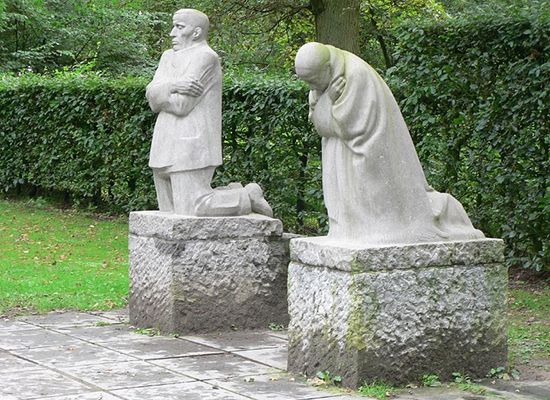
The Grieving Parents
Following Peter's death in 1914, the artist went through many iterations of how best to pay tribute to her son. Kollwitz began with drawings and sculptural models of a mother with her deceased child but then later decided to focus on depictions of the grieving parents. After she made this decision, she refused to let her husband Karl see her preparatory work.
Kollwitz's memorial materialized both the collectivity and isolation of parental mourning. As with her War print of The Parents, both parents kneel, with the father erect and the mother bowed in her despair. Neither can stand, and each physically clasps the body, as if both attempt to give comfort and to steel themselves against the overpowering weight of sorrow. Kollwitz indicates that while this deep despair is shared, it remains unique to each parent. In 1924, the artist reconceptualized the memorial, creating two, separate sculptures instead of one joint memorial, and she placed a distance between each parent. The separation of the figures allows visitors to see the graves and/or cemetery - the source of parental grief - between the two. This physical separation additionally underscores that each parent mourns alone, with the depths of each parent's psychological torment unique and inaccessible to the other.
Kollwitz staged the sculptures at their original site, the Roggeveld Military Cemetery in Flanders, for maximum emotional poignancy. The sculptures were installed flanking the entrance to the cemetery in 1932, with their backs turned towards the outside world, and their gaze directed at the cemetery. Visitors to the cemetery were then led into the grounds by the parents as their guides, to see the graves, in art historian Annette Seeler's terms, "from their vantage point" as mourners. Kollwitz "imagined visitors pausing in front of the figures on their return from paying respects at a grave of a family member," so that they could "look into the faces" and "find their feelings reflected in them." The images were not solely personal but also broadly political. Unfortunately, critics of the memorial did not acknowledge Kollwitz's anti-war political intentions.
The sculptures, along with Peter's grave, were relocated to the German Veterans' War Cemetery in 1956, where the installation dramatically differed from Kollwitz's original conception; no longer were the figures the back-turned guides for mourning and contemplation, leading viewers into the encounter with the dead. Copies of the sculptures were made in 1959 to honor the victims of both World Wars and again in 2014 for the Russian cemetery where Kollwitz's grandson Peter was supposedly buried as an "unknown soldier."
Stone - Originally in the Roggevelde Cemetery in Belgium, now in the Vladslo German War Cemetery
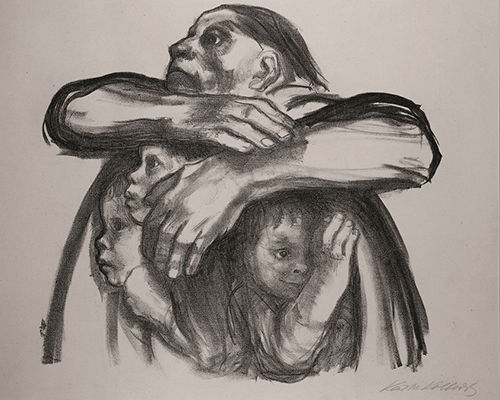
Seed for the Planting Must Not be Ground
Kollwitz found inspiration for her final print in text from Johann Wolfgang von Goethe's novel Wilhelm Meister's Apprenticeship, "Seeds for Planting Must Not Be Ground." She viewed this print as her "last Will and Testament" and completed the work quickly. The work represents the artist's despair and frustration that, yet again, the world was engaged in a war with an innumerable and senseless human cost. The artist interprets Goethe's line as a call to not prematurely truncate the lives of children for the purposelessness of war.
Consistent with her activist art and unique to Kollwitz, the artist couched stinging anti-war commentary within the seemingly innocent veneer of maternal love and the domestic environment. To illustrate her message, Kollwitz returned to a motif recurrent in her oeuvre, that of an old matriarch (somewhat resembling the artist herself), protecting children beneath an enveloping cloak. Two of the children on her left look outward, following the matriarch's gaze, suggesting that they may follow her message and stay away from the conflict, benefiting from her gesture of safety. The third child on the print's right, however, impishly peeks out from beneath his mother's cloak; he represents the idealism and independence of youth which may result in continued pointless bloodshed, despite the guidance, hope, and sheltering arms of previous generations' wisdom.
Lithograph - Staatliche Graphische Sammlung, Munich
Biography of Käthe Kollwitz
Childhood
Käthe Ida Schmidt (later Kollwitz) was the fifth child of seven born to parents Katharina and Karl Schmidt. Karl trained as a lawyer, but he declined to practice due to the incongruousness of his political views with the authoritarian Prussian state. He later joined the German Social Democratic Workers Party (SPD), but ultimately worked as a stonemason and became an expert builder. Katharina grew up in a strict, radically political and religious household. Katharina and Karl equally supported the professional aspirations of their four surviving children and ensured that their daughters received every educational and training opportunity available. Käthe's later progressive values and politics were firmly rooted in her childhood.
As a child, Käthe, known to her family as "Käthushcen" ("Little Käthe"), was nervous and shy and prone to seizure-like fits. Scholars have since attributed these fits either to the artist's anxiety and psychological repression or to a condition now known as "Alice in Wonderland Syndrome" in which one's sense perception is distorted. The death of three of her siblings, one prior to Käthe's own birth, exposed the artist at an early age to the quiet, eternal suffering of parental grief. Käthe was particularly awed by her mother's stoicism, concealed "deep sorrow," and emotional strength in the face of such loss, and she would later incorporate these childhood observations into her own aesthetic depictions of mourning.
Early Training and Work
Kollwitz began her artistic training in 1881, working with copper engraver Rudolf Mauer in Königsberg. She later studied painting and etching both in courses at the Women's School of Art in Munich and outside of official university programs, yet, the artist's nascent painting career remained frustrated by her difficulty with color. It was only after reading printmaker Max Klinger's 1885 brochure Malerie und Zeichnung (Painting and Drawing) that the artist realized she was "not a painter at all," but instead a printmaker.
In 1891, after a seven-year engagement, Kollwitz married Dr. Karl Kollwitz, a devoted socialist and an orphan who she befriended years prior while studying with Mauer. The couple moved to Berlin where Karl began a job as a physician, working to implement the provision of social and medical insurance for workers. In the big city, the juxtaposition of her studio space with Karl's medical practice resulted in her early interest in depicting the working-class women and children who came to see her husband as patients and who would often stay and discuss their troubles with Kollwitz. Working-class women would become her favored subject matter by the turn of the 20th century.
Kollwitz's decision to marry and risk the erosion of her professional independence was not an easy one and was complicated by the backlash she received both from her family and from her fellow female artists. Her father had expressed concern that the marriage might derail her artistic future, and, as a result, he worked to separate Kollwitz from Karl by sending her to different art schools over the course of their engagement. This paternal worry was shared by Kollwitz's fellow students at the Woman's School of Art in Munich, who derided Kollwitz for choosing a life path which they felt an inevitable death knell to an artistic career.
In 1892, the artist gave birth to her first son Hans, followed in 1896 by the birth of her second son, Peter. Kollwitz's children would subsequently become prominent subjects of her work. Karl Kollwitz was a dedicated husband and father, who, along with the family housekeeper, ensured that Kollwitz would have time to work on her art despite the demands of 19th-century motherhood. Kollwitz would later recognize her unique position as a woman privileged to be both a devoted artist as well as a devoted mother, and she came to the aid of one of her fellow Munich classmates who, unable to shoulder this dual burden, lived in poverty in Paris. In 1904, Kollwitz adopted this classmate's eleven-year-old son, Georg Gretor.
In 1893, Kollwitz saw the premier of the play Die Weber (The Weavers) by the poet Gerhart Hauptmann, an experience which represented a turning point in her career. The play told the story of an 1844 peasant weavers' revolt in which the weavers protested their low wages and horrible living conditions. The narrative inspired Kollwitz, whose childhood, personal views, and her husband's political involvement encouraged righteous activism. She would later identify this performance as a "milestone in my work," which caused her to abruptly cease all her previous artistic projects and turn to the translation of Hauptmann's tale into the six plate print series The Weavers (1897). The Weavers, in biographer Martha Kearns' words, "transformed" Kollwitz into "an artist who celebrated revolution." Kollwitz dedicated this first print series to her father, and she received the national Gold Medal upon its exhibition in Dresden in 1899. Of this honor, Kollwitz would later say that "from then on, at one blow, I was counted among the foremost artists of the country." In the late 19th century, Kollwitz became the only female artist in the avant-garde Berlin Secession group, Die Sezession, and in 1909, she began her sculptural career with a memorial bust of her maternal grandfather, Julius Rupp.
Mature Period
Art on behalf of Kollwitz's developing socialist values predominated her mature period, and the artist created prints which laid bare the realities of poverty in Berlin, or the exploitation of workers. Women became a focus of her works, and she created prints and posters that celebrated female revolutionary figures leading the charge of social change as well as the endurance, trials, and perseverance of working-class mothers that were under the most dire of circumstances. Her political engagements extended beyond her subjects, as she ensured the wide accessibility of her work through printing's easy replication and by pricing her prints at a low cost. Her prints circulated in magazines, and the Munich monthly Simplizissimus began to publish a series of her drawings entitled Portraits of Misery in 1909.
At the outbreak of the First World War, Kollwitz worked as a cook and helper in a cafeteria, feeding the unemployed as well as impoverished mothers and their children. Shortly after the start of the war, her son Peter died in battle in Belgium, and Kollwitz committed herself to pacifism. Though she remained a fervent socialist for the duration of her life, and though Karl was an active member of the SPD, Kollwitz herself never joined any of the progressive political organizations; she was not, in biographer Martha Kearns' words, "a political person in the orthodox sense."
It was during the First World War that Kollwitz's work began to be associated with the Expressionist movement. By this time, both iterations of German Expressionism, Die Brücke and Der Blaue Reiter, had been officially disbanded; however, the cultural associations with the Expressionist movement now generally identified the group as simply left-wing artists who worked in a non-realistic style. Though Kollwitz wasn't actually involved in either Expressionist group and though she was often opposed to the art of those artists typically considered "Expressionist" - often describing their works dismissively as "pure studio art" - the Expressionist label stuck to her. She, however, perceived her work to be of a style all her own, somewhere between naturalism and realism, with her compositional approach dictated by the emotional or activist needs of her images.
In 1920, after seeing work by printmaker and sculptor Ernst Barlach at the Berlin New Secession exhibition, Kollwitz began what would become her extended experiment with woodcuts. At the time, the artist had been searching for a printmaking alternative to etching, which her declining eyesight made difficult to manage, and to lithography, which she viewed as a problematic medium for printing a good, correct image. In addition to woodcuts, the artist expanded her practice to include sculptural projects.
Late Period
At the close of the Weimar era, Kollwitz's esteem as Germany's most successful female artist was at its peak. She was now widely recognized and had to hire a typist to manage her increasing correspondence (though she herself made a point to personally answer every letter).
With the rise of National Socialism, the artist's anti-war and leftist political leanings, as well as her non-naturalistic style, attracted Nazi attention. In 1932, after she had finally realized her memorial to her fallen son, Peter, she fretted over the placement of the memorial sculptures, concerned that the Nazis might, in curator Henriëtte Kets de Vries' words, "deface them with swastikas." The Nazis threated to dissolve the Prussian Academy unless Kollwitz and her colleague, both of whom had signed a petition attempting to unify the Left in advance of the elections, left their posts; she was then forced to resign from her professorship at the Prussian Academy in 1933. The oppressive and retrogressive conditions of Nazi rule also diminished her cultural prominence, and her work was censored. Yet, in the wake of Hitler's rise, so, too, did the political left turn from Kollwitz's example, with the Communist Party (KPD) determining, according to Vries, that her work was "too pessimistic as it failed to lift the workers out of their plight, and focused instead on their misery." Though rejected by the right and the left, Kollwitz continued to make sculptural work, even as she believed that these later pieces were ultimately ineffective, as "[e]verything has been said before."
In 1936, the Gestapo began a year-long campaign against Kollwitz, threatening to send her to a concentration camp if she did not renounce her anti-Nazi sympathies and cooperate with them by naming other anti-Nazi artists. The threat was ultimately not carried out, perhaps due to the support and protection she received as a beloved member of her surrounding community, but, from that point on, Käthe and Karl each carried a vial of poison to use in the event of capture by the Nazis.
Karl's practice was banned in 1938, and Käthe and Karl descended into poverty. Refuge in America was offered by a collector, but Kollwitz declined, preferring to remain near her family. Meanwhile, the Nazis used her activist prints, such as her poster Brot!, for their own propaganda, as her images were widely known and emotionally accessible.
Karl Kollwitz died in 1940, and, in 1942, Kollwitz's grandson, her son Peter's namesake, died during the war while fighting in Russia.
In 1943, Kollwitz evacuated her home in Berlin, which was razed by bombs shortly thereafter. Many of her works were destroyed in the attack, as well as photographs, letters, and mementos of Karl, her son Peter, and her grandson Peter. She was forced to evacuate from her temporary lodgings one more time, in 1944, to the Mortizburg estate of collector Prince Ernst Heinrich of Saxony. Filled with despair at war's unending destruction and human toll, Kollwitz asked her son Hans in June 1944 for permission to commit suicide; he asked that she refrain, at least until the war's conclusion, out of a sense of responsibility as a prominent role model. On April 22, 1945, Käthe Kollwitz died of heart failure at the age of seventy-eight.
The Legacy of Käthe Kollwitz
Kollwitz was instrumental in increasing the visibility and professional validity of women artists in the interwar years. In 1916, she was voted to become the first woman juror of the Berlin New Secession, and in 1919, she became the first woman elected to the Prussian Academy of the Arts (though she refused to use the title of "professor"). She helped found the Society for Women Artists and Friends of Art in 1926 and was appointed the first female department head at the Prussian Academy of Arts in 1928. Kollwitz's work was internationally renowned in her lifetime. In 1927, she visited the Soviet Union as a celebrated guest to mark the tenth anniversary of the Communist state.
It should also be noted that Kollwitz exemplified the potential for a female artist to be both a prolific and celebrated practitioner and a successful and devoted wife and mother. Despite the reservations both her female artist peers and her own father held, Kollwitz, with the support and encouragement of her husband Karl and the childcare aid of her housekeeper, remained a strident activist and meticulous printmaker even while fulfilling the duties required by 19th- and early-20th-century domestic social norms. While childcare responsibilities sometimes delayed her print projects, or resulted in "wretchedly limited working time," she maintained that as a mother, "I was more productive because I was more sensual; I lived as a human being must live, passionately interested in everything." The emotional resonance of her prints betray the depth of her engagement and identification with her primary subjects - women, mothers, and children - and illustrate the successful navigation of her dual roles as an artist wielding her images in passionate advocacy for social change as well as that of a parent and spouse.
Her example as a successful female artist caught the attention and admiration of other modern women, including Dadaist Hannah Höch, who included Kollwitz's image in her famous collage, Cut with a Kitchen Knife Dada through the Last Weimar Beer Belly Cultural Epoch of Germany (1919-20), as well as the much later Guerilla Girls, who adopted names of prominent historical women, to bring attention to the lack of female representation in museums and the art world. Kollwitz's exploration of psychic depths can also be traced to portrait painters like Alice Neel, who also conveyed a range of emotions across a diverse selection of sitters from all walks of life.
As an activist, Kollwitz's work had a long and profound influence, due not only to her images' graphic expressive immediacy but also to the circulation of her prints on posters and postcards. In keeping with the use of propaganda posters as "one of the most powerful tools for rallying the masses" following the First World War, according to curator Henriëtte Kets de Vries, Kollwitz illustrated posters to denounce poverty and hunger, to abolish anti-abortion laws, in support of the women's movement and to call for the removal of criminal charges for homosexual acts, among many other progressive causes. Her anti-war posters, particularly her Central German Youth Day poster with the text "Never again War!," have particularly affected subsequent generations, and curator Claire C. Whitner notes that the Gary Yanker collection of propaganda art at the Washington, D.C., Library of Congress contains innumerable, anonymous poster riffs on Kollwitz's original image. She has, in addition, been an inspiration for many Chinese graphic artists, beginning when her work was greeted with enthusiasm there in the 1930s through to the present day.
Influences and Connections

-
![William Hogarth]() William Hogarth
William Hogarth -
![Auguste Rodin]() Auguste Rodin
Auguste Rodin -
![Francisco Goya]() Francisco Goya
Francisco Goya ![Max Klinger]() Max Klinger
Max Klinger- Ernst Barlach
- Paul Cassirier
- Gerhart Hauptmann
- Otto Nagel
- Albert Einstein
- Thomas Mann
-
![The Guerrilla Girls]() The Guerrilla Girls
The Guerrilla Girls ![Sue Coe]() Sue Coe
Sue Coe- Li Hua
- Frances Clark
- Hedwig Weiss
- Agnes Smedley
- Muriel Rukeyser
- Lu Xun
- Kelley Aitkin
-
![German Expressionism]() German Expressionism
German Expressionism - Chinese Woodcuts
- Propaganda art
Useful Resources on Käthe Kollwitz
- Käthe Kollwitz and the Women of War: Femininity, Identity, and Art in Germany during World Wars I and IIOur PickBy Claire C. Whitner
- Käthe Kollwitz: Die Plastik. WerkverzeichnisBy Annette Seeler
- Käthe Kollwitz in DresdenBy Petra Kulhmann-Hodick, et al
- Prints and Drawings of Käthe KollwitzBy Carl Zigrosser
- The Diary and Letters of Käthe KollwitzBy Hans Kollwitz
- Käthe Kollwitz: Woman and ArtistBy Martha Kearns
- The Passion of a German Artist: Käthe KollwitzBy Klemens von Klemperer
 Ask The Art Story AI
Ask The Art Story AI